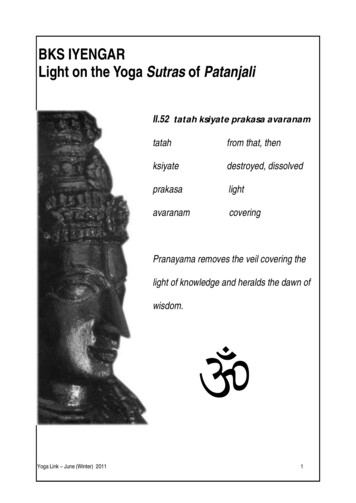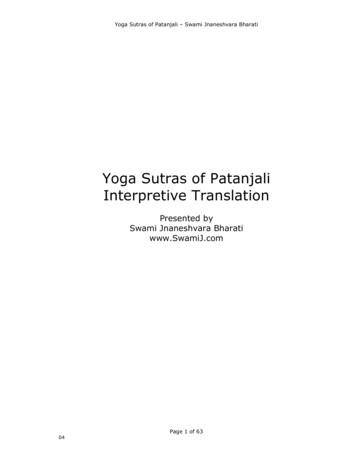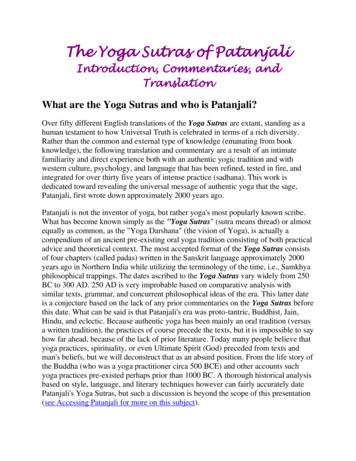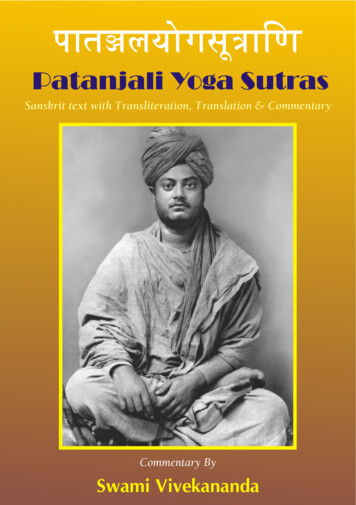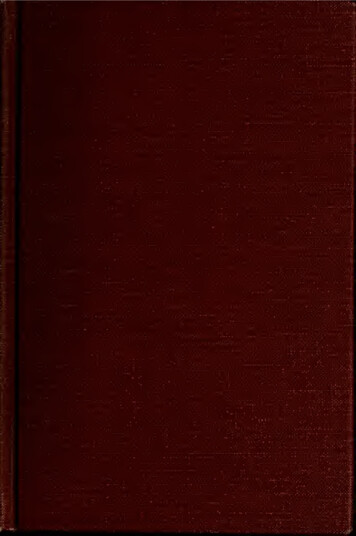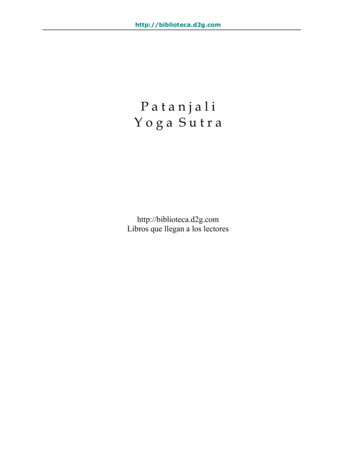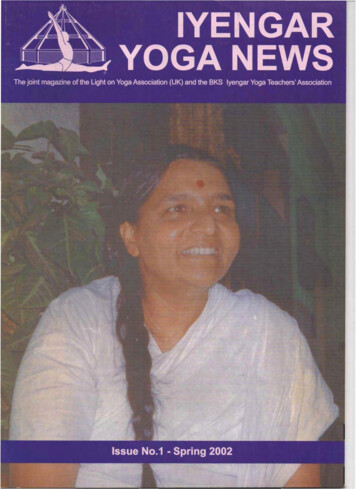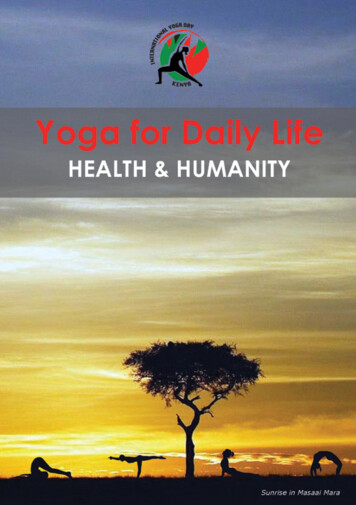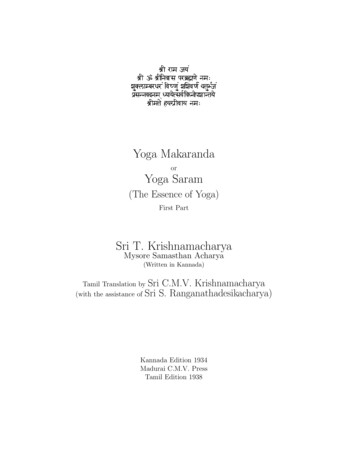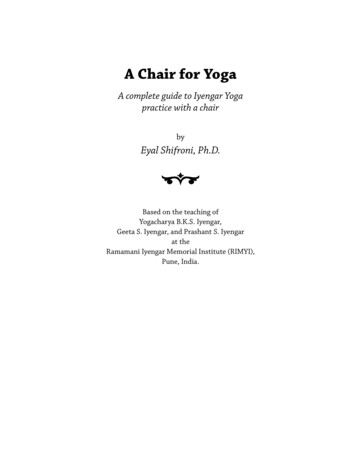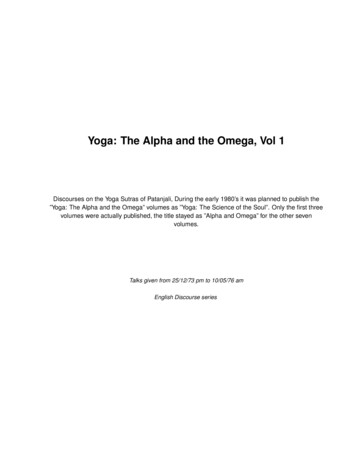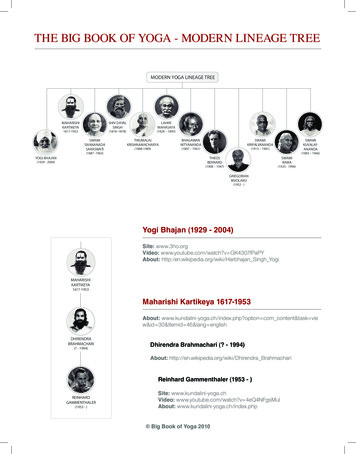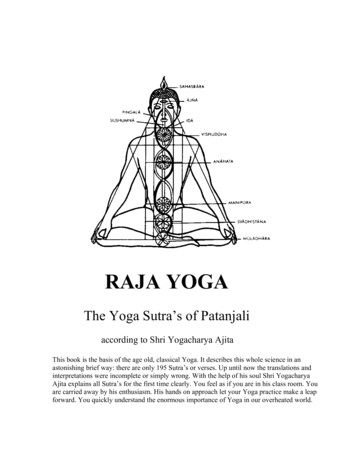
Transcription
RAJA YOGAThe Yoga Sutra’s of Patanjaliaccording to Shri Yogacharya AjitaThis book is the basis of the age old, classical Yoga. It describes this whole science in anastonishing brief way: there are only 195 Sutra’s or verses. Up until now the translations andinterpretations were incomplete or simply wrong. With the help of his soul Shri YogacharyaAjita explains all Sutra’s for the first time clearly. You feel as if you are in his class room. Youare carried away by his enthusiasm. His hands on approach let your Yoga practice make a leapforward. You quickly understand the enormous importance of Yoga in our overheated world.
IntroductionDear Yoga friend,It is with pleasure that I offer you this work as an inspiration tool for your Yoga practice. Itcontains, as far as I can see, the highest knowledge about Yoga, and complements my earlierbooks, Subtle Anatomy, Hatha Yoga Pradipika and Science of Soul.The basis of this book consists of my comments of the book “Yoga Sutra’s of Patanjali,translated and commented by I.Q. Taimni” during my classes of the Yoga Teachers TrainingCourse 2003-2006 on the Monday evening. Ester Eriksen has recorded my comments andmade the transcription, for which she has my eternal gratitude.This book contains the inspired lectures and all discussions which happened in the group. Thetone is therefore often very lively.Since 1984 this book has been an important part of my Professional Yoga Training, whichconsists of a Basic-, a Teacher- and a Master Training Course, as described in my websitewww.xs4all.nl/ rajayoga/EN or www.raja-yoga.orgIt is funny that even before editing this book Swami Maitreyananda Sarasvati, President of theWorld Yoga Council, has already asked me permission to translate it in Spanish.May this book help you reach Enlightenment.May this book contribute to the spreading of Yoga in the world.Yours friendly,Shri Yogacharya Ajita(Philippe Barbier)Honorary Secretary of the International Yoga Federation for the European UnionPresident of the European Yoga Council of European Yoga AllianceHonorary Life Member of the World Yoga CouncilMember of the International Yoga Therapy CouncilMember of the Coregroup of the Samenwerkende Yogadocenten NederlandDirector of the Raja Yoga InstituteIlpendam, Holland, July 30th 20072
tPrefaceChapter I : Samadhi PadaChapter II : Sadhana PadaChapter III : Vibhuti PadaChapter IV : Kaivalya Pada3
PrefaceIt is a remarkable book indeed.Once I started a collection of all possible versions of the Yoga Sutra’s of Patanjali from diversesources (comments/translations). The version written by Taimni is the last and only one thatremains. Among all versions it proved to be the least poor.It is horrifying what you find in all those books. Written by people who know nothing aboutthis business, but still find they ought to add their cent’s worth. In Yoga, if you have some, ifany ambition, I think that as a matter of habit one should write his own comment on theseYoga Sutra’s Characteristic of a good edition is that it does not only contain the original Sanskrit text intransliteration (in letters that we can at least understand a little), but also a literal translation,which means word by word, followed by a normal translation that reflects the meaning in dailylanguage and a comment on it.It would be truly perfect when the curly characters of the Nagari-script would be added. Thatof course would be very nice, were it not that most of us are not able to read Nagari-scriptanyways. For that matter, Sanskrit can be put down in various styles of script of which onlyone is Nagari. There are many other styles of curly characters of which one is Brahmi.What kind of scripture is this and who is the author?It is not possible to determine how old this scripture is and where it came from, as nothing isknown about the author Patanjali. All we know is that his name is Patanjali. What is known,however is that the basis of Yoga science lies here.Was this the first Yoga scripture in history?Probably not, but it seems to match with other very old scriptures. The Hatha Yoga Pradipikaon the other hand is clearly from a later era.This one has most likely been written somewhere before Christ.One can only admire the geniality of this fairly short scripture that exists only out of 195verses, cryptic verses or formulas as it were.In former times they were written down on a palm leaf by the Yoga practitioners and rolled upin the form of a scroll, tied with a cord and carried on the back. It was their most preciouspossession. An example of this can nowadays still be seen in the British Museum in London.In the Yoga schools of former times these 195 Sutra’s were memorized, so it was only normalthat the students could recite them by heart.The Sutra’s are probably reminders that were specifically designed to help the teacher as aleading thread running through the lessons. He and his pupils used them as a kind ofcompendium, a reminder like “oh yeah, that’s what it was about!”Remarkably enough only 500 different words were used in these 195 verses. This is typical forYoga: to tell the issues with a minimum of words.4
The Sutra’s thus are very concise in structure, very short. It is for this reason that they are oftenvery difficult to understand. That is the reason why there are so many interpretations of them.Sutra’s have a magical value and are used as Mantra’s because they awaken information in thesuper-consciousness as well as in the sub-consciousness. This is difficult to explain but let’ssay I take the book, I open it, I read a Sutra, give it some time to sink in, and immediately itevokes certain things. Then I can talk about it with a wisdom that perplexes me. Really, nokidding, often I just listen to myself, hearing what a wonderful story it is I’m telling. It is funnyfor sure, because just a moment ago I didn’t have the slightest clue.Sutra’s also have a kind of prophetic power, or an explanatory power:When you put the Sutra’s on your night table, and at a certain moment you just don’t knowwhat to do with your life, or certain questions arise, you just open the book, at any given page,and you will see, the answer is right there in front of you. I have done it like this many timesand it works.The Sutra’s are the basis of what we call classical Yoga, also called Ashtanga Yoga ofPatanjali. Ashtanga means 8 steps. Classical Yoga is the first, original Yoga, from which all thelater forms of Yoga have originated.The ancient quality test for any form of Yoga practice is: “Does your Yoga practice consits ofthe 8 steps of Patanjali?”You can bring up Karma Yoga, or Bhakti Yoga or Tantra Yoga or Kundalini Yoga or nameany kind, but it should always contain the 8 steps of Patanjali.If that is not the case, it is not Yoga. This is the present standard of the International YogaFederation.Yoga cannot be explained in any other way, because then it is wrong. Just keep it professional,as it was meant to be from the beginning. If the commentator/author of the sort of Yoga inquestion wants to do right to Yoga, the original Yoga, he considers all 8 steps. From themoment he deviates from this, he is not doing it right.Why not?Because the 8 steps deal with the whole human being: emotional, moral, physical, mental,spiritual. That is what those 8 steps are for. And it is impossible to make man develop properlyif you take only one or some of the steps and leave some of the others out. If you want to helppeople develop you must deal with the whole, because it is a closed circuit.If for example you take Bhakti Yoga, and you say: “Look, I refer to the Narada Bhakti Sutra’s”(Narada author who plays the most important role in Bhakti Yoga). But the Narada BhaktiSutra’s do not mention the 8 steps of Yoga, well, then it is time to watch your steps, becausesomething is not right.In many of the Yoga forms the 8 steps are not mentioned. How do we have to perceive this?This means that problems have occurred.For example in Bhakti Yoga, in which Mantra’s are used.The Narada Bhakti Sutra’s - which are a very short scripture - are to be observed when youfocus on the practice of Mantra. This scripture describes that when practicing Mantra there are2 parts: Bhava – mood, and Shabda – sound. Especially Bhava is important. You have to put so5
much emotion into the sound that tears are rolling down your cheeks. That is a technique, itworks perfectly, and it is okay to use it, but you are putting an accent on one aspect only. Butthe rest of Yoga also has to be regarded when you do that. If you only focus on just one aspect,you are in danger. And that is exactly what happens so often. One plunges into Bhakti andcreates an overdose of Shiva within. This creates increasingly Tamas. As a result emotions arenot under control. The principle of Pratyahara is ignored. That is when things go wrong, withwhole groups of people at once. Because everybody thinks he is doing things right. In India itis even worse than here because Bhakti Yoga has many followers there.Also in Bhakti Yoga one needs to learn the techniques of Samadhi. That means all of them, andnot just one technique of meditation or contemplation. So all 8 steps, and not to forget theYama’s and Niyama’s.How do you think about the T.M. movement?The Maharishi respects the 8 steps, so that is a valuable example. I don’t care what they do orhow they do it, if only they would respect the ground rules. We are awaiting their results. Theyare not as good as ours, but anyways A lot of people of the Maharishi come here to receive extra training. What we do qualitativelyis incomparable. Even for those who have followed their Siddhi program.In Yoga you always have to respect the 8 steps. You can directly dive into a step of Yoga andenjoy, but keep in mind that it is part of the totality. When you read a novel, you have to havelearned something about grammar. The Sutra’s of Patanjali are like the grammar of Yoga, andno less.Often the 8 steps are all taken into account, but then Pranayama practice is wrong, doingbreathing techniques instead of mental energy controlVery often that is indeed the case. From the moment they practice Pranayama as breathing it iswrong, even when they say they practice correctly.In such cases I always think: “Let’s talk about it, and compare the results we achieved, how wegot there, and no hard feelings”.I have tried that several times, but the problem is always that I feel as if I am standing in frontof a brick wall. They don’t want to talk about it. They don’t want to compare. They don’t wantto check. They just accept it dogmatically: “This is how it is and that’s it.” With such anattitude, whether they are right or wrong, I am out of there!It is because it’s not fair. It is not open. Still I think that we are seriously proving that ourapproach is the right approach.Take the technique of Pratyahara for example.The technique of Pratyahara is not being taught anymore – not in the whole wide world! Wehave adopted this technique from Swami Yogeshvarananda Sarasvati. Pratyahara is describedin his first book: “First steps to Higher Yoga”.A lot of people in the Yoga-world know this author, know the school he directed, and respecthim very much, but Pratyahara is hardly taught anywhere.6
I think that he was one of the top Swami’s of this time.I don’t understand that this doesn’t get any attention, except for Buddhism, in which they doclearly explain about this matter, but in other Yoga forms there is hardly any mention of it.Just remember: if you want to seriously practice Yoga you have to know that it exists out of 8steps, as Patanjali one day established it.Yoga has an alternative name, which is Raja – royal. This is not a different kind of Yoga. It isYoga, described by admirers as being royal, a title that was given to it later because it was sovenerable, so brilliant. But it was also a basic ingredient of the training of kings. You could saya course for top managers.In the same vein you find the famous book of Sun-Tzu, The Art of Warfare, in militaryacademies.Princes, future kings got this on their plate.There are examples of kings who were completely trained and educated on this basis, like kingJanaka from the Mahabharata.Do you actually feel like being a king?Probably not. In each case not the kinds of king as we know them nowadays in the Westernworld. “King” in fact is a term used to name a master, a person who is fully awakened. TheBuddha has probably received this as study material.There are many similarities between his teaching and the Yoga Sutra’s of Patanjali.We learned about the philosophy of the Klesha’s. They are the same as in Buddhism.Some people take offence with what I am saying: Buddha is a great Yogi who received RajaYoga training. It took 7 years to reach enlightenment with Raja Yoga. Indeed he may havedeveloped his own style or form of Yoga, in which he has overlooked a couple of steps.Does this mean that Buddhism is actually a part of Yoga?Yes, but be careful when you mention this to Buddhists. Obviously they don’t agree.From the moment that you talk with a Buddhist about the fact that you practice Yoga, he looksat you disapprovingly or immediately starts a discussion with you. And rightly so. At leastwhen you practice the usual Yoga, as most people know it these days. Because he doesn’tknow that you learned Yoga in this school. And with the material that you have learned in thisschool you will wash the ears of the Buddhist with his own doctrine. And he will be baffledand say to you: “Yes, but what you are telling me now, that is Mahayana Buddhism”.There are 2 directions in Buddhism: the Hinayana and the Mahayana – the lower path and thehigher path.What can you tell us about Hinduism?Yoga is the basis of Hinduism. There are about 240 million Hindus. From the moment that youfollow the Hindu religion you automatically become a Yoga practitioner.All the gods have been added later. It has become an
Yoga cannot be explained in any other way, because then it is wrong. Just keep it professional, as it was meant to be from the beginning. If the commentator/author of the sort of Yoga in question wants to do right to Yoga, the original Yoga, he considers all 8 steps. From the moment he deviates from this, he is not doing it right. Why not? Because the 8 steps deal with the whole human being .
